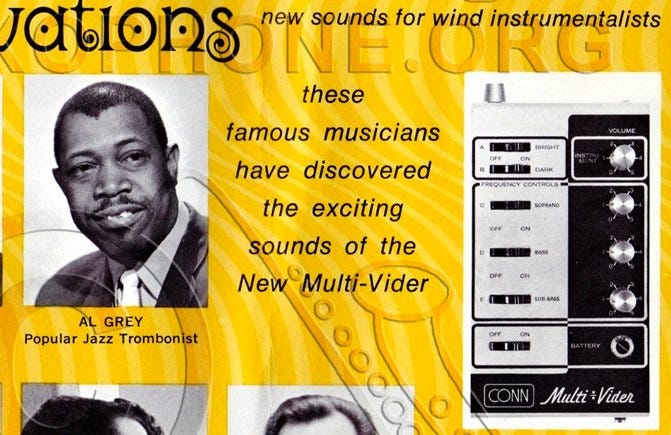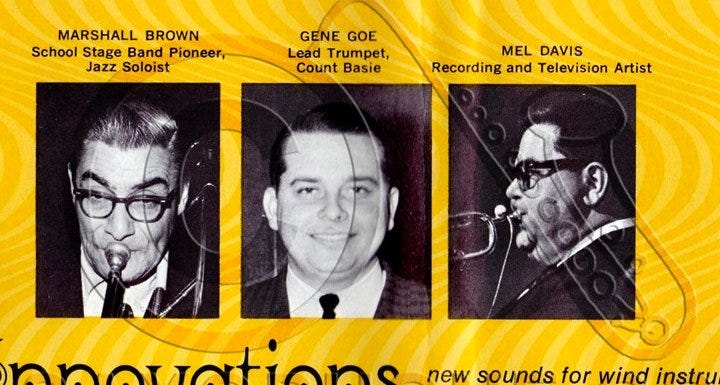This is my 30th year in NYC and I’m feeling a little introspective. I’m close to 50. Sometime around middle school I decided to be a professional weird jazz trombone player. I thought, unlike my normie classmates, I was gonna be edgy and cool. What folly! Still, it blows my mind that, decades later, some young people have the same idea.
Consider this: when I jumped into this boat, around 1990 or so, there were still profitable print magazines, newspapers with critics who reviewed shows, record deals, and album sales. This generation, now in their 20s and 30s, had no such illusions about their careers. Yet they still chose this life. Props to them.
Of these seven players, only two live in NYC.
Everyone of this batch of players has made electronics an important part of their careers. “Electronics?” you might say, “my favorite swinging jazz trombone players never had anything to do with that. “ How wrong you would be! Let’s take a trip down memory lane, to a time when jazz trombone players were at the forefront of electronic manipulation.
Back in the late 60s, a surprising number of jazz musicians were digging electronics. This snippet from a 1968 Conn catalogue shows Al Grey and Marshall Brown endorsing the Conn Multi-vider.
Green Power from 1971, features Urbie Green using a similar device along with an echoplex.
J.J. Johnson, god emperor of bebop trombone, used a pitch follower and synthesizer to augment his trombone on his 1980 album Pinnacles.
In a 1999 interview he said
If you walked into my home and saw my Midi studio, you wouldn't believe it: the computer, the laser writer, the keyboard controller, the interface, plus all of the devices...Midi is my hobby. When I'm not working, when I'm in Indianapolis, I dabble in Midi.
Astute jazz fans may be more familiar with George Lewis’s pioneering work with interactive electronics in the 1980s or Robin Eubanks’s use of pedals in the 90s. Trombonists have been plugged in for a long time.
Kalun Leung lives in Montreal. With a collaborator, he’s invented an augmented electronic system for trombone called a “mubone”. It’s gone through various incarnations but the latest one actually fits inside the bell as if it’s the world’s most sophisticated mute. It has location sensors that can be programmed to respond as you move the instrument in 3 directions.
For my album Clear Line I had Kalun play the crucial 3rd trombone parts (3rd is the chair I usually play in big bands!). He plays with a beautiful sound on Adam O’Farrill’s new album “For These Streets”. There’s an abstracted solo on “Scratching the Surface of a Dream”.
Daniel Bruno is an Argentine improviser who plays the trombone. One could also say his instrument is video editing software. You may be turned off from Instagram jazz musicians who post shitty sounding practice videos or sloppy play-alongs of famous solos, staring at the camera, perhaps reading from a tablet, or admiring their wide-angled iPhone camera embouchures like a stretched out modern day narcissus. Rather than using social media as an easy, mediocre way to present music, Bruno is truly posting as a new medium, creating video miniatures which cannot be performed live.
While all these players come from the electrically enhanced trombone tradition, Kalia Vandever and Andy Clausen come from a specific lineage: that of brass players making use of large reverberances. This goes all the way back to our renaissance era churchy beginnings. In the last century Stuart Dempster made a series of innovative ambient brass recordings starting with 1979’s “In The Great Abbey Of Clement VI“. Bassist and French Horn player Willie Ruff had an unbelievably eclectic career ranging from studying with Hindemith to playing bebop bass behind the Iron Curtain with Dwike Mitchell to playing on the debut album of Leonard Cohen. He also made a stunning recording of Gregorian Chants and spirituals inside St Marks Basilica in Venice, the same cathedral that trombone players played in in the 1600s.
When I first heard Kalia, I loved her strong, singing, melodic sense. Her absolute avoidance of jazz trombone cliches instantly set her apart from legions of trombone wannabes (aka how to get on Jacob’s good side). She also played on my album “Clear Line”.
Andy is best known for the indie-adjactent brass quartet the Westerlies. Andy’s album uses a real reverberant space in a Colorado grain silo while Kalia’s uses digital reverberance. Andy uses looping to occasionally create high-pitched, sped-up playback while Kalia tends to create ambiences that stay in the register of the horn, but both use digital effects to create sustained drones and harmonize their own playing. Andy plays original music, pieces by Motian, Frisell, and two standards. Kalia’s music is her own. Both these albums are lovely and haunting.
Robinson Khoury is French, has Lebanese heritage, and plays the shit out of the trombone. His videos are slickly produced but do not gloss over his serious musicianship and experimental approach. My favorite tracks from his album Broken Lines are the short pseudo-classical sequences, Estampe 1, 2, and 3.
Many trombone players have futzed around with playing the slide without the bell section, but this is surely the most in tune and musical version since Teagarden.
Alex Paxton, born in England, is not very well known in trombone circles but is an accomplished, published composer with an impressive record of prestigious commissions. He’s carved out a unique niche: that of the deft, imaginative orchestral composer whose work often features himself playing exuberant free jazz trombone. This creates an interesting dichotomy: His writing for the orchestra is meticulously notated state of the art contemporary classical, intended to be played with precision. But his solo playing is fluid, passionate, and far removed from the staid sounds of orchestral trombone. His swiftly changing, maximalist writing is twee, in a good way. It sounds like contemporary music written from within the universe of the Trolls movies.
Zekkereya El-magharbel is based in Detroit and is an accomplished visual artist as well as trombonist. Possessing one of the most beautiful tones in the business, they create both conventional “albums” on bandcamp as well as innovative social media posts.
In dozens of short videos Zekkereya explores different maqams from Arabic classical traditions. The reels on their IG page seem like a sort of primer, or a musical diary. Video posting didn’t exist in the golden age of jazz. Can you imagine what Lester Young or Duke Ellington would have done with the ability to inexpensively create and distribute hundreds of short films? We must view this type of creation through a completely new prism.
“5 named scenes live from a parallel dimension in which Europe does not exist“ features exquisite improvising over a surreal overdubbed backdrop. Strikingly original, the lo-fi aesthetic and mind-melting premise gives it a time-travelling Borgesian quality, like a newly discovered record made by a futuristic but long-hidden civilization.
Zekkereya can be heard in an acoustic context on Alec Goldfarb’s wild microtonal/blues mash-up “Fire Lapping at the Creek”.
Yes, I know, I omitted your favorites, but hopefully this post will be one of a series. Got to check out what the people younger than yourself are doing, lest you be left behind!








But isn't the trombone always already weird?
Thanks for this, really fun and heartening. I feel hopeful about the future.
I'm intrigued that you've talked about all these different ways of quote-distorting-unquote the trombone sound. It's deeply funny to think of Al Grey, master of the plunger, continuing to explore other ways of manipulating his sound.
I'm also excited these days by musicians (perhaps most prominently Amir ElSafar and Hafez Modirzadeh) exploring different scales and tunings -- Modirzadeh has re-tuned pianos, right -- and have been meaning to re-listen to the Lou Harrison piano concerto (Keith Jarrett has recorded it I think) and if memory serves the orchestra is strings and trombones because they can play in the temperament Harrison has written for (I have probably gotten some details wrong and welcome correction).
This is my long way around to requesting that you share your thoughts about mutes, plungers, and temperament some time!
Thanks for tipping us the wink to these great musicians. Keep the recommendations coming!